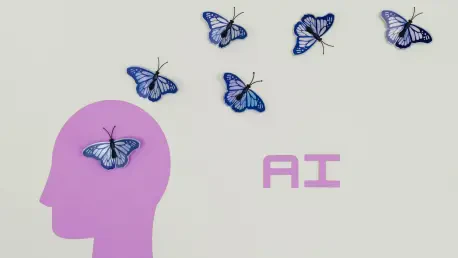Introducing Kofi Ndaikate, a seasoned expert in the Fintech arena, his insights span multiple industry sectors including blockchain, cryptocurrency, and regulatory policies. Today, we delve into how Zafin is leveraging AI, specifically ChatGPT Enterprise, to transform its product development and delivery practices. With mounting challenges facing banks from outdated infrastructure to evolving customer demands, Zafin aims to use AI not as a mere tool but as a strategic capability embedded throughout the organization.
Can you explain how Zafin is integrating ChatGPT Enterprise into its product development and delivery operations?
Zafin’s integration of ChatGPT Enterprise is a fundamental shift in how our teams approach product development and delivery. By embedding AI into the heart of our operations, we are enhancing development velocity and product quality. AI supports us in streamlining processes, enabling sharper focus and efficiency, which translates into delivering personalized products and services at unprecedented speeds. From ideation to execution, ChatGPT Enterprise is woven into our workflows to unify human expertise with AI, fostering a collaborative environment that accelerates innovation.
What are the main benefits Zafin expects from embedding AI into its processes?
The benefits are multi-faceted. Primarily, integrating AI helps us address outdated infrastructure and competitive pressures by improving our agility and responsiveness. The technology empowers our teams to concentrate on innovation-centric tasks, reducing manual cycles, and boosting productivity. Furthermore, AI enhances decision-making through enriched insights and streamlined operations, which accelerates the introduction of new capabilities into the market. Quality and precision are also heightened, ensuring we align closely with the evolving needs of our bank clients.
How does Zafin’s collaboration with OpenAI align with the company’s AI principles?
Our collaboration with OpenAI is deeply rooted in shared values around human-AI collaboration. OpenAI’s technical leadership and ethical approach resonate with Zafin’s AI principles centered on trust, control, and precision. Together, we are shaping how intelligent systems and human expertise work in concert, ensuring a balance that adheres to our clients’ stringent needs for reliability and security. This partnership is a testament to our commitment to responsible scaling and ethical AI practices.
Can you discuss the specific challenges banks face today and how Zafin aims to address them?
Banks are grappling with the dual pressures of outdated infrastructures and the need to swiftly adapt to digital-first challengers. There’s also the constant demand for personalized customer experiences, which requires agility and precision. Zafin is positioned to tackle these issues by scaling platform capabilities and fostering high-impact innovation. Our AI integration helps banks streamline product delivery, making it easier to meet evolving customer expectations while maintaining the quality and reliability that clients demand.
In what ways does ChatGPT help Zafin accelerate innovation and improve product quality for banks?
ChatGPT is more than a productivity tool; it’s a catalyst for innovation. By harnessing generative AI, we expedite the ideation phase, reduce complexity, and enhance decision-making processes across teams. This integration allows us to focus more on high-impact activities rather than manual tasks, thus enabling our products to achieve greater precision and responsiveness to customer demands. The direct outcome is improved product quality and faster availability of solutions to our banking partners.
Can you elaborate on the role of AI in streamlining ideation and enhancing decision-making at Zafin?
AI plays a crucial role in transforming ideation from a lengthy, cumbersome process to a streamlined experience. By providing real-time data insights and predictive analytics, AI helps us make informed decisions quickly and with clarity. This enhancement moves our teams from reactive to proactive stances, facilitating smarter strategies and solutions. AI-driven ideation helps refine our focus, direct resources efficiently, and ensure alignment with client needs.
How is Zafin using generative AI beyond just a tool and embedding it as a strategic capability across the organization?
Generative AI is embedded into the fabric of our operations, serving as a strategic capability that permeates all departments. It elevates efficiency in documentation, cross-functional knowledge-sharing, and collaboration workflows. Our teams, fueled by AI-driven insights and interfaces, can collaborate more effectively and with greater creativity, fostering an environment ripe for innovation. The technology is a core element of our strategy to differentiate ourselves and offer competitive advantages to our clients.
What internal workflows at Zafin are benefiting from the application of OpenAI models via ChatGPT Enterprise?
Multiple workflows across Zafin have transformed fundamentally since integrating OpenAI models. From prototyping and documentation to enablement and collaboration, AI application accelerates processes, freeing our teams to focus on strategic projects that drive innovation and value. For example, documentation cycles are shortened significantly, allowing for quicker turnaround times and improved accuracy. This shift supports our vision to make teams superhuman and enhances our capacity to respond to client needs with speed and precision.
How does Zafin ensure responsible scaling when adopting AI technologies?
Responsible scaling is paramount to Zafin’s AI strategy. We adhere to a comprehensive AI governance framework that incorporates human-in-the-loop oversight and rigorous risk management protocols. These measures ensure that all AI initiatives yield outcomes that are explainable and aligned with client needs, maintaining transparency and accountability. By balancing AI automation with human judgment, we safeguard the integrity and security of our processes while leveraging AI’s potential to its fullest.
Can you describe the three strategic areas Zafin’s AI initiatives focus on?
Our AI initiatives concentrate on collaboration enablement, platform delivery acceleration, and future development. Collaboration enablement focuses on documentation, knowledge-sharing, and intelligent interfaces that streamline operations across departments. Platform delivery acceleration involves embedding AI in product design and QA processes to elevate quality standards and expedite delivery. Future development looks ahead to innovative solutions, building agent teams that boost the capabilities across the platform, informed by OpenAI SDKs and governed by enterprise standards.
How does Zafin’s responsible AI governance framework maintain outcomes that are explainable, auditable, and aligned with client needs?
Our governance framework is crafted to ensure that all AI-driven outcomes are both transparent and accessible. By integrating human oversight and risk management protocols, we maintain accountability and alignment with client expectations. This framework guarantees that all processes remain explainable and auditable, providing insights into decision-making paths and maintaining the quality and integrity our clients expect. It is a foundation of trust that banks rely on to safeguard their operations and reputation.
What measurable gains has Zafin seen in development timelines, QA cycles, and documentation delivery since integrating AI?
The integration of AI has delivered substantial improvements across development timelines, QA cycles, and documentation processes. We have experienced faster project delivery times and enhanced product quality thanks to streamlined workflows. Documentation delivery has become more efficient, with teams able to produce and revise materials rapidly and accurately. These gains translate to quicker time-to-market for new capabilities, enabling us to serve clients more effectively and with greater agility.
How does Zafin balance AI automation with human judgment to achieve desired outcomes?
Balancing AI automation with human judgment is critical to achieving our target outcomes. We combine the analytical prowess of AI with the nuanced understanding that human expertise offers. This symbiotic relationship ensures processes remain grounded and responsive, maintaining high standards of quality and relevance. Human oversight in AI-driven processes safeguards against errors and biases, ensuring that outputs meet client demands and regulatory requirements.
Can you share early results or examples of new capabilities delivered to the market faster thanks to AI integration?
Early results have been promising, showcasing advances in product delivery speeds and quality. For instance, we’ve expedited the rollout of custom banking solutions previously hampered by lengthy development cycles. These capabilities were brought to market faster, offering clients innovative tools to enhance customer engagement and adapt to changing demands. The agility gained through AI integration continues to empower our teams to innovate and delight our clients with cutting-edge solutions.
Do you have any advice for our readers?
For readers navigating the complex realm of AI in banking, my advice is to embrace AI as a strategic partner that elevates human capabilities rather than replaces them. Align AI initiatives with organizational principles, ensuring responsible deployment and transparent operations. By fostering a culture of collaboration between AI tools and human expertise, businesses can drive meaningful innovation that anticipates and meets customer needs effectively and efficiently.









